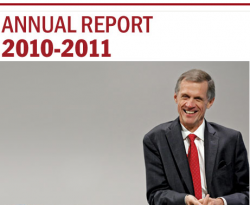 This (standard) cliché is repeated over and over by the world’s public employers in their most valuable marketing piece, their annual report. We know it’s B.S. You know it’s B.S. … and so does everyone else.
This (standard) cliché is repeated over and over by the world’s public employers in their most valuable marketing piece, their annual report. We know it’s B.S. You know it’s B.S. … and so does everyone else.
Employers, in their infinite wisdom, realize that investment in their firm, at least in part, is subject to the public perception that cash, bricks, and mortar aren’t the only factors in a firm’s success and, at the very least, some reasonable effort to avoid outright abuse of their employees is critical to supporting the brand they’ve managed to build. To that extent, employment and product brands are intertwined.
One could note that sales of clothes, for example, tend to go downhill quickly when a little light shines on them being made with child labor at starvation wages in some distant country.
Taking a more traditional approach, however, the critical work by Becker, Huselid, and Ulrich on the HR Scorecard during the last couple decades demonstrates that if we can improve the engagement of our workforce, those higher engagement scores coupled with our (HR) scorecards tend to be statistically correlated with increased corporate performance.
So, occasionally, it’s not B.S. There are times when firms actually walk the talk and reap the rewards of managing a great workforce. Sounds like a value proposition for HR to me.
What if we could all agree (agree? I know, but there is a point to this ludicrous speculation. I promise) on a couple of the metrics that differentiate between how employers manage their workforce for performance and those who are simply engaged in a creative writing exercise? And, god forbid, what if we discovered that those companies in the former group did perform better!
People seeking to invest their money might want to know a little more than, “Our employees are our best asset” when they read the company’s literature.
Public firms walking the talk might want to share more of those measures to attract their fair share of investment.
There is, amazingly, a methodology for obtaining agreement (consensus) on professional issues developed by the American National Standards Institute, a body recognized by (and sitting at the table of) the International Standards Organization (ISO).
And, for the last four years, with SHRM as sponsor and underwriter, literally hundreds of professionals involved in every aspect of HR — researchers, vendors, consultants, practitioners, educators, etc. — have been debating incessantly over dozens of fundamental HR terms, measures, and practices with an eye to creating an agreement on standards.
It takes time … two to four years for each standard, so the work isn’t for the faint of heart, those easily frustrated, or for the folks with lots of opinions and little else to back it up or for folks frustrated by folks with lots of opinions and little else.
And we’re not talking about a standard that everyone must use but, instead, a voluntary standard that people would want to use, adopt, or comply with because of the imbedded logic of the agreement.
Take cost-per-hire as an example. It may not a true measure of staffing efficiency or productivity, but it is one small component in developing such an ROI. Everyone thinks they know what it is, but there are dozens of definitions being used in the workplace. No two software applications calculate it the same way. Arguably some would say we should not be measuring hire cost at all because we tend to place too much emphasis on it.
But, if we are going to measure it, why not agree on what it is. Then, we can emphasize its appropriate uses from a common base.
It took three years of public and private debate to reach consensus on cost per hire, but as of February 2012, there is, in fact, an ANSI approved definition of cost-per-hire.
Employers now have a comprehensive document that covers the subject. Hundreds of academics, practitioners, educators etc. have agreed on it. Vendors, including most notably ADP, have already adopted the standard and reconfigured their software to comply with it. Next stop ISO.
Time to up the ante.
The person who led the workgroup under the SHRM/ANSI Staffing and Workforce Planning Standards Taskforce that obtained consensus on CPH now heads the HR Metrics Standards Task Force established in 2011. This newly formed Task Force created a workgroup on HR Investor Metrics and volunteers were sought. They came and debated and even engaged colleagues in the finance and investment communities to participate. Their initial thinking in what is likely a two- to three-year process was recently placed in Public Review.
And all hell broke out.
That a few noses were out of joint is an understatement. To catch up I would refer you to the July 23, Businessweek article entitled HR Group Creates Workforce Metrics and Kris Dunn’s HR Capitalist/FOT blog, HRPA to SHRM: We Don’t Need No Stinking Standardized HR Metrics.
For those looking to create some real disruption over the next few years, I would encourage you to join the standards movement. Our manufacturing colleagues get it; few firms fail to comply with ISO 9000 and similar standards.
You can argue all you want that HR is different. But there will then come a time when an HR equivalent of ISO 9000 is adopted and … we may know whether your employees are your firm’s greatest asset … and what to do to make it so.
(Sooner, rather than later, there could even be voluntary standards for the treatment of candidates. What a radical notion that would be. #tiltingatwindmills.)